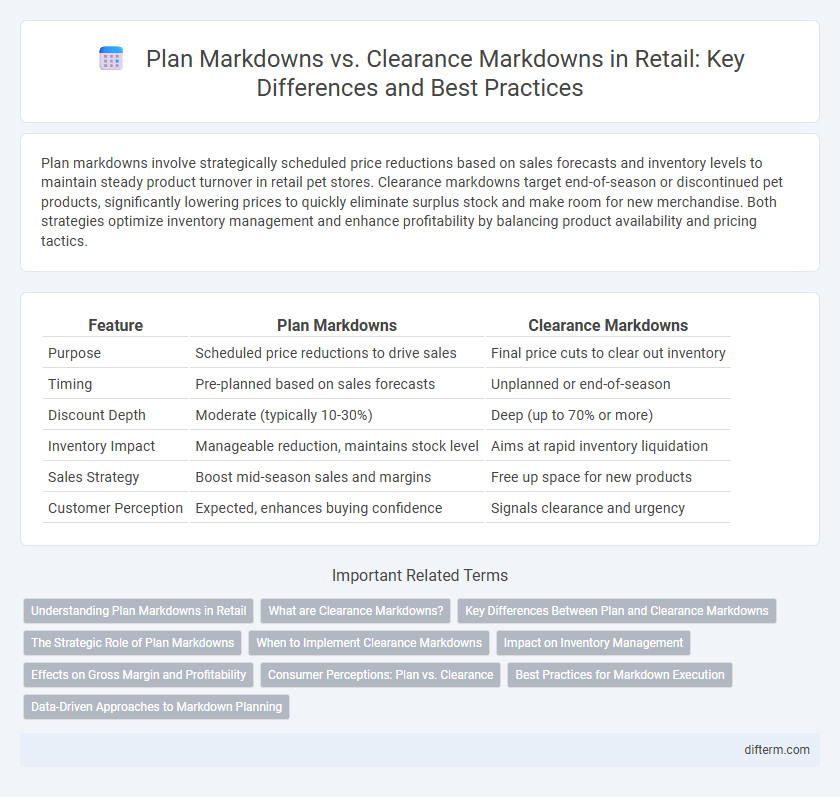Plan markdowns involve strategically scheduled price reductions based on sales forecasts and inventory levels to maintain steady product turnover in retail pet stores. Clearance markdowns target end-of-season or discontinued pet products, significantly lowering prices to quickly eliminate surplus stock and make room for new merchandise. Both strategies optimize inventory management and enhance profitability by balancing product availability and pricing tactics.
Table of Comparison
| Feature | Plan Markdowns | Clearance Markdowns |
|---|---|---|
| Purpose | Scheduled price reductions to drive sales | Final price cuts to clear out inventory |
| Timing | Pre-planned based on sales forecasts | Unplanned or end-of-season |
| Discount Depth | Moderate (typically 10-30%) | Deep (up to 70% or more) |
| Inventory Impact | Manageable reduction, maintains stock level | Aims at rapid inventory liquidation |
| Sales Strategy | Boost mid-season sales and margins | Free up space for new products |
| Customer Perception | Expected, enhances buying confidence | Signals clearance and urgency |
Understanding Plan Markdowns in Retail
Plan Markdowns in retail are premeditated price reductions strategically scheduled to manage inventory levels, optimize sales velocity, and improve profit margins. These markdowns are based on sales forecasts, seasonal trends, and product life cycles, ensuring consistent turnover without sacrificing brand value. Understanding Plan Markdowns helps retailers balance supply and demand effectively, minimizing clearance necessities and maximizing full-price selling opportunities.
What are Clearance Markdowns?
Clearance Markdowns are significant price reductions applied to retail merchandise to expedite the sale of excess, outdated, or seasonal inventory. These markdowns help retailers free up shelf space and minimize holding costs by converting slow-moving products into cash. Clearance Markdowns differ from Plan Markdowns, which are pre-planned promotional discounts intended to drive sales volume rather than clear out stock.
Key Differences Between Plan and Clearance Markdowns
Plan markdowns are pre-scheduled price reductions based on inventory levels, seasonal trends, and sales projections to maintain product flow and profitability. Clearance markdowns occur spontaneously to quickly liquidate excess or non-moving stock, often at steeper discounts to free up shelf space. The key difference lies in plan markdowns being a strategic, controlled pricing adjustment, while clearance markdowns serve as reactive measures targeting inventory clearance.
The Strategic Role of Plan Markdowns
Plan markdowns play a strategic role in retail by proactively managing inventory levels and maximizing profit margins through scheduled price reductions based on sales forecasts and seasonal trends. These markdowns help retailers avoid excessive clearance markdowns, which are reactive and typically result in lower margins due to urgent need to clear unsold stock. Integrating plan markdowns into merchandising strategies improves cash flow, optimizes shelf space, and supports overall financial performance by aligning pricing with consumer demand patterns.
When to Implement Clearance Markdowns
Clearance markdowns should be implemented when inventory levels exceed demand forecasts or seasonal sales periods conclude, signaling a need to free up space for new merchandise. These markdowns effectively enhance cash flow by accelerating the liquidation of slow-moving or end-of-season products. Retailers optimize profitability by timing clearance markdowns to coincide with shopper buying cycles and inventory turnover rates.
Impact on Inventory Management
Plan markdowns strategically adjust prices based on predetermined schedules, enabling more accurate inventory turnover forecasts and reducing overstock risks. Clearance markdowns accelerate the sell-through of slow-moving or excess stock, freeing up warehouse space and minimizing holding costs. Effective use of both markdown types balances inventory levels, optimizing cash flow and enhancing overall stock management efficiency.
Effects on Gross Margin and Profitability
Planned markdowns, strategically scheduled during product life cycles, help optimize inventory turnover while maintaining steady gross margins by balancing price reductions with anticipated sales volume. Clearance markdowns, often reactive to excess stock or seasonal shifts, can significantly erode gross margin and profitability due to deeper discounting required to liquidate inventory quickly. Effective management of both markdown types through data-driven pricing strategies enhances overall profitability by minimizing margin losses and improving cash flow.
Consumer Perceptions: Plan vs. Clearance
Planned markdowns are perceived by consumers as strategic price adjustments that maintain product value and encourage timely purchases, often signaling promotions or seasonal shifts. Clearance markdowns typically carry a perception of urgency and deep discounts, suggesting limited stock and end-of-lifecycle products, which can both attract bargain hunters and deter value-conscious shoppers. Understanding these differing consumer perceptions helps retailers balance inventory management with brand image and sales goals.
Best Practices for Markdown Execution
Plan markdowns should be strategically scheduled based on sales data and inventory levels to optimize profit margins while maintaining customer interest. Clearance markdowns require more aggressive price reductions aimed at quickly liquidating leftover stock to free up retail space and reduce carrying costs. Employing integrated inventory management systems and real-time sales analytics helps retailers execute both markdown types effectively, ensuring optimal timing and pricing adjustments.
Data-Driven Approaches to Markdown Planning
Data-driven approaches to markdown planning leverage historical sales data and predictive analytics to differentiate plan markdowns from clearance markdowns effectively. Plan markdowns are strategically timed price reductions aimed at optimizing inventory turnover based on forecasted demand patterns, while clearance markdowns occur as reactive measures to liquidate excess or slow-moving stock. Utilizing advanced algorithms and real-time sales insights enhances decision-making, minimizes margin erosion, and maximizes profitability throughout the retail markdown lifecycle.
Plan Markdowns vs Clearance Markdowns Infographic

 difterm.com
difterm.com